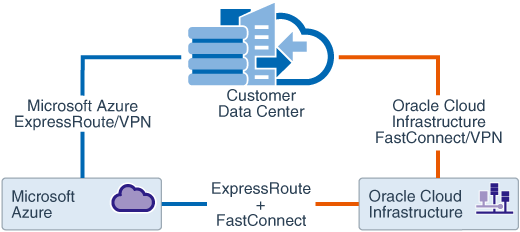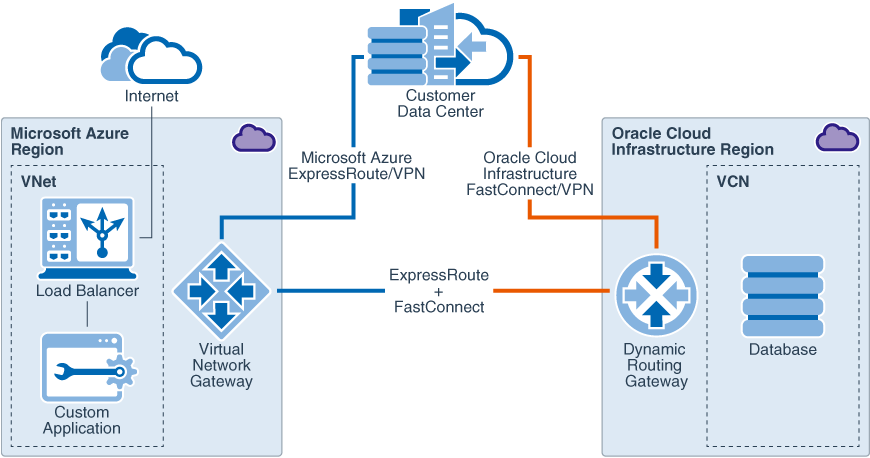Learn About Connecting Oracle Cloud with Microsoft Azure
You might deploy your cloud workloads on Oracle Cloud and Microsoft Azure for various business and technical reasons. Such workloads need a secure, low-latency interconnection between Oracle Cloud and Microsoft Azure.
About the Interconnect Partnership Between Oracle Cloud and Microsoft Azure
Oracle has partnered with Microsoft to provide low latency, private connectivity between Oracle Cloud and Microsoft Azure. This partnership gives you a highly optimized, secure, and unified cross-cloud experience. Use the best of services from Oracle Cloud and Microsoft Azure, and continue to leverage any existing investments in Oracle and Microsoft technologies.
- Migrate to the cloud or build cloud-native applications by using the best of Oracle Cloud and Microsoft Azure.
- Set up extremely low-latency, private connections between workloads distributed across Oracle Cloud and Microsoft Azure.
- Extend your on-premises data centers to both Oracle Cloud and Microsoft Azure.
- Provide single sign-on (SSO) access to resources deployed in Oracle Cloud and Microsoft Azure.
- A secure intercloud connection that bypasses the public internet.
- High availability and reliability through redundant 10-Gbps physical connections.
- Predictable cross-cloud network performance.
- One time setup without the need for any intermediate network provider.
Architecture
The partnership between Oracle and Microsoft enables you to set up a secure, direct connection between Oracle Cloud and Microsoft Azure.

- For private access from your data center to Oracle Cloud, use either Oracle Cloud Infrastructure FastConnect or IPSec VPN. Similarly, for private traffic from your data center to Microsoft Azure, use ExpressRoute or VPN.
- For cross-cloud networking between Oracle Cloud and Microsoft Azure, set up a connection between a FastConnect circuit in Oracle Cloud and an ExpressRoute circuit in Microsoft Azure.

- For administrative access from your data center to the database in Oracle Cloud, use either Oracle Cloud Infrastructure FastConnect or IPSec VPN. Similarly, for private access from your data center to the workload in Microsoft Azure, use ExpressRoute or VPN.
- For cross-cloud networking between Oracle Cloud and Microsoft Azure, set up a connection between a FastConnect circuit in Oracle Cloud and an ExpressRoute circuit in Microsoft Azure.
The traffic between the clouds is isolated and secure. Traffic from networks other than Oracle Cloud and Microsoft Azure can't reach either cloud through the cross-cloud connection. For example, traffic from your data center can't reach Oracle Cloud through Microsoft Azure.
- On the Oracle Cloud side, the FastConnect virtual circuit terminates at a dynamic routing gateway (DRG), which is attached to a virtual cloud network (VCN).
- In Microsoft Azure, the ExpressRoute connection ends at a virtual network gateway (VNG), which is attached to a virtual network (VNet).
- Traffic from the application to the database is routed through the VNG in Microsoft Azure to the DRG in Oracle Cloud. Traffic in the opposite direction is routed through the DRG to the VNG. In both directions, the traffic never leaves the private network.
About Required Services
This solution requires the following Oracle Cloud services:
- Oracle Cloud Infrastructure Networking
- Oracle Cloud Infrastructure FastConnect
See Learn how to get Oracle Cloud services for Oracle Solutions to get the cloud services you need.
- Microsoft Azure Virtual Network
- Microsoft Azure ExpressRoute